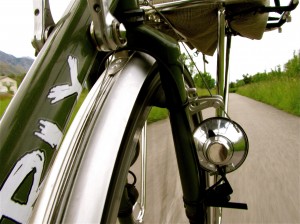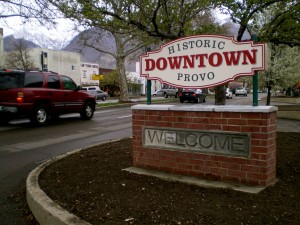We just recently received a link to a great article from World Watch Institute (thanks Jan). The article goes into pretty good detail on the benefits cycling has on a community and on a city. The article is titled Power to the Pedals and was written by Gary Gardner. Mr. Gardner takes a very holistic approach to cycling in urban centers such as our Historic Downtown.
One of Gardner’s first points on cycling and how it can help cities is found in these lines,
For the community, cycling means an improved urban ambiance thanks to decreased congestion and pollution, better quality of life because of proximity to bike paths and increased open space, and sounder fiscal health via increased economic activity and reduced taxes.
He then goes into further detail on how these things can be reached and what the broader effect is to the citizen and city. Moving from city centers and economic development Gardner goes on to talk about car dependence and the over arching issues that stem from car dependence. He first touches on one of our valleys greatest concerns air quality:
Even for trips of a mile or less, private vehicles account for 60 percent of trips in the United States. Commuting is potentially a high-payoff opportunity for pollution reduction from cycling. A bicycle commuter who rides four miles to work, five days a week, avoids 2,000 miles of driving and (in the United States) about 2,000 pounds of CO2 emissions, each year.
The information above is great but, only half the story. When ever you are bike riding and not driving whether it is one mile or four, you are not only helping the air you are helping your wallet. Every time you ride you save money on gas and on wear and tear on you car. From here Gardner goes on to talk about one of our nations (many) biggest concerns sedentary lifestyle:
three 10-minute biking trips provide sufficient levels of physical activity to protect against sedentary lifestyle diseases.
Basically riding your bike to the grocery store, or to dinner, or to a friends house only three times a week will keep your body happy and working right. I would say that is a pretty good trade off transportation for fitness and health.
My family and I go everywhere we can by bicycle. There are definitely motives such as health, air quality, awareness, etc. that many people have for riding. For my family however, it is just because we love our bicycles and love feeling connected with the place that we live (not to mention if we are going anywhere downtown it is way faster to ride a bike) all those other things are fringe benefits to something we already love. Every once and awhile someone will ask if I ever worry about my 2 1/2 year old or wife being on the road riding bicycles. Their reasoning is that riding bicycles is very dangerous. Gardner has an answer for those who may worry about this as well:
Data from Australia show that a person is seven times more likely to be hospitalized playing football than riding a bike, for example. And the British Medical Association has reported that the health risks of inactivity are 20 times greater than the risks from cycling. Moreover, pro-cycling policies can increase the perception of cycling as a safe activity, and increase cycling rates. For example, “traffic calmingâ€â€”reducing automobile speeds using physical enhancements such as speed humps or legal tools such as reduced speed limits—appears to encourage people to bicycle.
From here Gardner cites one of my favorite cities other than Provo, Portland OR. He breaks down the numbers of riders and trips on bicycles then relates those numbers to safety showing that more ridership means less incident. This at first seems counter intuitive but, if you check any city that has a great cycling infrastructure you will find these numbers to be true. In wrapping things up Gardner gives eight things that every city should strive for to receive the benefits of cycling. They are:
• an extensive network of bike paths and lanes• traffic calming• intersection modifications• bike parking• integration with public transport• training and education• promotional events• complementary taxation, parking, and land-use policies. Most important, they say, these initiatives must be taken together, comprehensively.
Throughout the entire paper Gardner is talking to cities and citizens. He talks a bit on how some of these programs can be hard to implement sometimes because government can get bottle necked and inactive. However if you read through the whole thing it reads a lot like a bicycle rides. It is the individual, the citizen bicycle rider who decides they want better health, or better economy, or better air quality. The citizen is in charge of these changes, just as it is the individual bicycle rider that must pedal their own pedals towards some goal.
Through his paper Gardner does a great job of showing many of the benefits of cycling and dispelling some of the greater misconceptions. I recomend everyone to read through the paper if they have time. But, if you have a choice between reading his paper or going on a bike ride I think you know which choice to make :). When you do take time to read through the whole thing I recomend you forward the article to your council member, or the Mayor, or the city engineers. Basically forward this to anyone you think will benefit from the infromation. Since Gardner did such a good job pulling together all this information I will leave you with his closing words.
Similarly but to a greater degree, advancing cycling may be the best buy in raising a city’s quality of life. Not only does cycling capture the manifold benefits of moderate exercise, it is good for a city’s environment, livability, and fiscal health. As cities worldwide struggle with pollution, as carbon-reduction strategies become urban-focused, as obesity rates rise in rich and poor countries, and as municipal budgets are squeezed by growing demands for services, the bicycle is increasingly embraced as a multi-pronged solution by city halls worldwide. The logic for their widespread adoption suggests that they could remake the look and feel of cities this century.



Dude! Great info. Also my commute home today was awesome. There were tons of bikes on the road today. People from every demographic:little kids in packs, moms wearing heart monitors, hipster kids on fixies, serious road bikers decked out in spandex, chubby girls just trying to make it home from work with out getting hit, and more. For the first time ever I waited behind a stranger on a bike at a light. I am sweaty and tired but it rocked! Everyone should commute by bike. The world would be a seriously better place, especially Utah Valley!
I love when people send BikeProvo links to the cycling articles they’ve found. Thanks for the excellent recap, Zac. It’s inspiring how much creating a cycling culture / environment can improve urban and downtown areas.
Hey I took that Downtown Provo photo! Woo!